I had believed that after my last post as the ghost blogger for Amelia my duties would be over, as I am expecting her to come back early next week. However, the problem with nature is that we can not predict its course, we can only observe and wonder.
When I returned from England on my own and opened the house I noticed quite a number of bees dead near each window. Then as the evening approached and I sat down with a cup of tea in the stillness of the setting sun I could hear them under the roof space. Looking outside I saw that a lot of bees had found a couple of small holes and were coming and going. I telephoned my friend Michel, the bee keeper, who kindly came and inspected and then returned a second time, fully “armed” and placed an empty hive fully laced with honey and a special product to attract the bees.
 In the hours that followed the bees did come out of the roof space and seemed very happy to discover a new source of food so close to home.
In the hours that followed the bees did come out of the roof space and seemed very happy to discover a new source of food so close to home.
 More and more bees were attracted to the hive No 2.
More and more bees were attracted to the hive No 2.
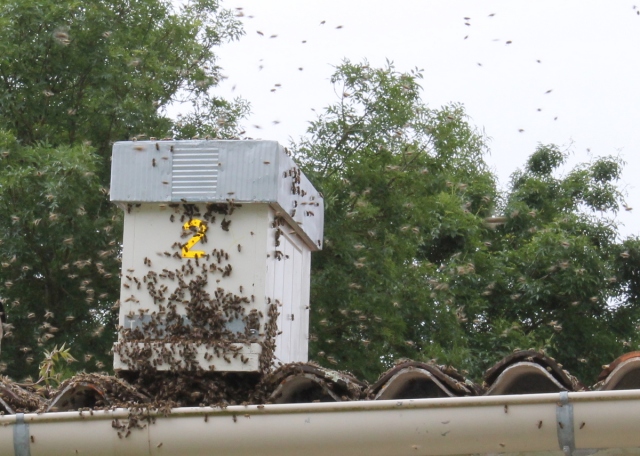 But, as Michel explained to me, once the hive was covered by the bees, the queen would no longer enter the hive. So we left it like that for a few hours more. Michel left and I started to get ready for bed. It was then that I noticed what had happened. The queen apparently had abandoned the roof space [thankfully] but indeed had not gone to the new hive, but had settled on the branch of the apricot tree nearby. And the bees had swarmed around her.
But, as Michel explained to me, once the hive was covered by the bees, the queen would no longer enter the hive. So we left it like that for a few hours more. Michel left and I started to get ready for bed. It was then that I noticed what had happened. The queen apparently had abandoned the roof space [thankfully] but indeed had not gone to the new hive, but had settled on the branch of the apricot tree nearby. And the bees had swarmed around her.
 There was nothing else I could do as a heavy rain had just started which continued throughout the night. I did telephone Michel again and he returned once more in the morning. This time he brought the hive down from the roof.
There was nothing else I could do as a heavy rain had just started which continued throughout the night. I did telephone Michel again and he returned once more in the morning. This time he brought the hive down from the roof.
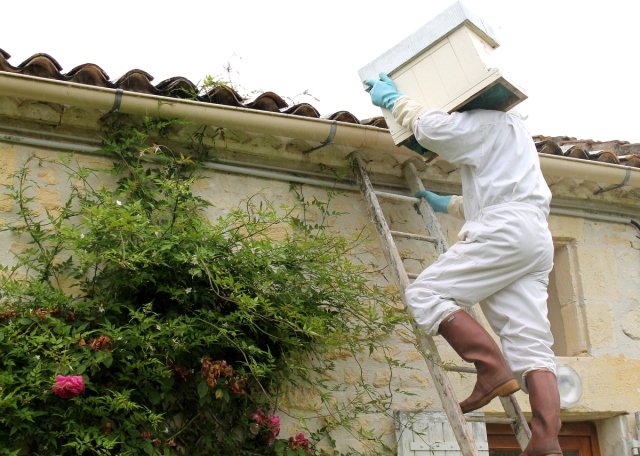 and removed the slats inside it.
and removed the slats inside it.
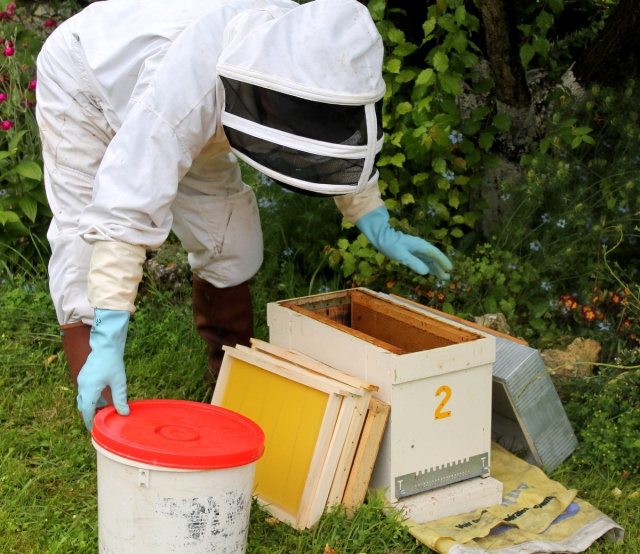 He then shook the branch of the tree and collected all the bees and the queen in a bucket.
He then shook the branch of the tree and collected all the bees and the queen in a bucket.
 He made sure that as many bees were collected.
He made sure that as many bees were collected.
 Once he was satisfied that he had indeed collected the bees, he literally poured them into the empty hive.
Once he was satisfied that he had indeed collected the bees, he literally poured them into the empty hive.
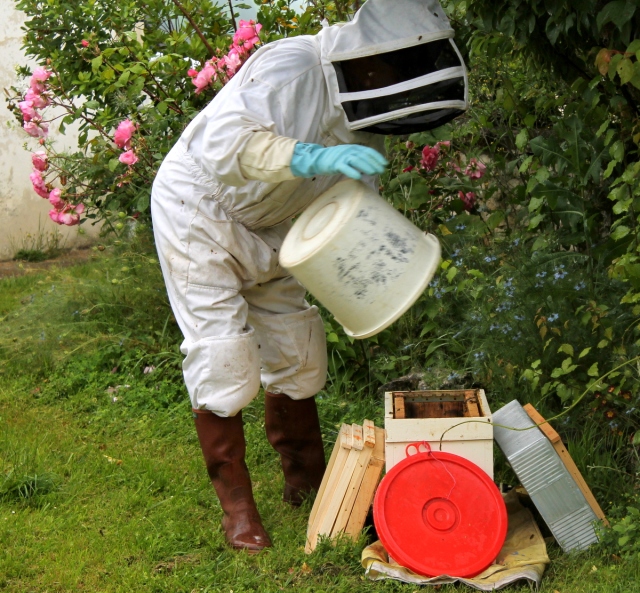 He then proceeded to replace the slats one by one into the hive.
He then proceeded to replace the slats one by one into the hive.
 Finally he replaced the cover.
Finally he replaced the cover.
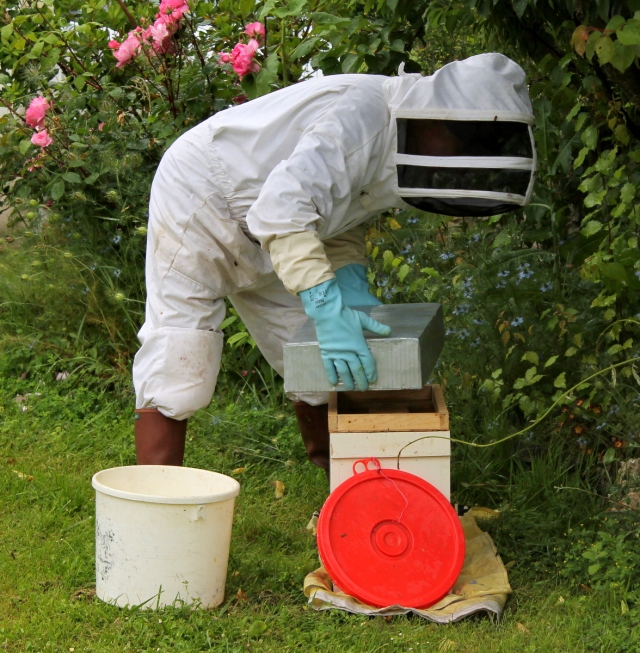 He has now left the complete hive in the garden to give any straggler the chance of returning to their new home.
He has now left the complete hive in the garden to give any straggler the chance of returning to their new home.
So, Amelia, I know you always fancied having a bee hive of your own. Now, whether you like or now, for the moment you have a bee hive right in your front garden. Come back soon, please! – K


How exciting; I’m sure Amelia must be very envious of all the ‘fun’ you are having without her!
LikeLike
She is envious. But I am also envious of her being able to cuddle our new grand-daughter. – K
LikeLike
Poor Amelia, missing this amazing display of nature being nudged along by man. Great photos, great story telling, and now Amelia has her very own hive. Not a bad couple of days effort!
LikeLike
Thanks for the comments. What I did not tell you was that during those few days I had to keep rescuing more bees that somehow were finding a way to enter the house through tiny holes in the wooden ceiling. And I had to be very careful as I am allergic to wasp and bee sting! – K
LikeLike
What an exciting development. Nature gives us wonderful stories to tell.
LikeLike
You are absolutely right! When we just look around us and listen, there is so much to experience and to learn – K
LikeLike
Will the hive stay at your place now for the summer?
LikeLike
Sadly I let Michel take the hive to his garden which is not far from us and keep the bees beside their sisters. Anytime Amelia fancies she can go for a visit. – K
LikeLike
Fascinating documentation of a process we may need… two days ago we found there are bumble bees in part of our roof. We are waiting to see if they are a problem. If not, they may stay for now!
LikeLike
They shouldn’t cause a problem. Bumble Bee colonies are much smaller than Honey Bees — only about 200 individuals at most. A beekeeper won’t be much help in removing them anyway.
LikeLike
I am not an expert, but I understand that the bumble bees do not form a colony as large as the honey bees. Generally they are not a problem. I am glad that you found the series of photos interesting.- K
LikeLike
Great photo report! I wonder if honey bees particularly like apricot trees? Our neighbour has just had a swarm in her apricot tree. Our house in England would get bees in the roof every year, and one year we had honey dripping from the ceiling.
LikeLike
That is a very interesting observation, which may prove to be true. The apricot tree [similar to cherry trees] oozes a sweet gum from some branches. I will not be surprised if the insets like bees find them attractive.
I am so glad I didn’t have honey dripping from the ceiling. The bees that found their way through small homes were rescued by me and let outside. – K
LikeLike
I’ve seen huge bee swarms on tree branches twice in my life. It’s an amazing and rare thing to see. Lucky you have a friend who is a beekeeper!
LikeLike
That is what friends are for, specially when they have special skills like Michel. He told me that our swarm was not terribly big, nevertheless a few thousand honey bees at one time were a little impressive. – K
LikeLike
Fascinating stuff. Great post. 😀
LikeLike
Thank you. I am glad that you found it interesting. – K
LikeLike
Wow! It is very funny that you have this ‘thing’ for bees and they actually came under your roof (literally!). Anyway that is a very clever way to take care of them, although it’s a totally “don’t try this at home” kind of thing, you definitely need some kind of pro! I am fascinating by that picture of the bee ‘blob’ formed on the apricot tree.
LikeLike
I took the series of the picture to share the experience with Amelia and of course you. The “blob” is the swarm and Michel told me that it was actually fairly small. – K
LikeLike
Very cool story–and nicely documented with photos. So now, do you seal up the holes in the roof?
LikeLike
Michel showed me where the holes are. I have sprayed the area with sulphur [the same that I use to treat the fruit trees]. The odour is supposed to deter them; and then I have sprayed polyurethene foam. Nobody told me that life in the country was this complicated – still we love it! – K
LikeLike
Very interesting story, in words and in pictures. It must have been a little terrifying for you, with your allergies. I’m glad a beekeeper was available to come to the rescue. And I’m glad there was a happy ending to the story.
LikeLike
Although I am allergic I did not find the whole thing terrifying. I was amazed by the bahaviour of the bees and I learnt a great deal. I was indeed sorry for the dead bees that I initially found dead in the house and I rescued any that I found alive. But to collect the swarm and re-house the queen and her children in a hive was something that did require a beekeeper. I am glad you found the story interesting.- K
LikeLike
Glad this was you and not me. I am allergic to bees! Diane
LikeLike
I am like you, Diane, allergic to wasp and bee sting, and at this time of the year I also suffer from hay fever. Nevertheless, Michel assured me that they will not attack me and although I had to go fairly near to take lots of photos, The bees were friendly enough. One or two sat on my clothes but Michel pushed them away. When we visit his garden, Michel warn us to stay away from one particular hive [he has over 20 hives]. That hive the bees tend to be more aggressive.
It was all in all a very interesting experience. – K
LikeLike
I used to live in a cottage which had a bee colony in the chimney. They would swarm repeatedly throughout the summer and provide some local beekeepers with fresh colonies. Never seen a swarm poured into a hive before though. Always an amazing sight to see a swarm. Dave
LikeLike
Dave, we have had swarms in the chimney before and eventually we evicted them by smoking them out and then blocking that chimney. For once the phérormones from the queen is there, the bees tend to smell it and return.
A swarm is amazing. It often reminds me that the world “civilization” was coined when human beings lived together and became citizens and formed cities. But is it not what some animals like bees have been doing long before us? – K
LikeLike
Our chimney was blocked off internally so we were happy to leave the colony be. The bees will also be attracted back by any honey left behind of course. Sadly, the new owner of that house had the bees poisoned (despite knowing that they had lived there for decades). But because she didn’t have the chimney thoroughly cleaned – the bees returned. Which pleased me no end. D
LikeLike
Great post, excellently illustrated. Enjoyed it a lot! RH
LikeLike
Unaccustomed as I am to blogging, I am grateful for your encouragement. – K
LikeLike
Well you’ve picked it up very quickly, in the recent absences of the Blog CEO! RH
LikeLike
Fascinating! What a great story and set of photos! Thanks.
LikeLike
Thank you, Sue. I am so glad that you found the story interesting. I myself found the work of nature truly amazing. I just had one pity that Amelia was not here to share the experience. – K
LikeLike
This is my favourite post all week! What a great story! And what a brilliant ghost blogger!
LikeLike
I am really glad you liked the blog. The bees are truly amazing – but I think you already know that; and I have just found that out. – K
LikeLike
This post is a beautiful example of how blogging and the internet allow sharing of experiences and information, I enjoyed it a lot.
LikeLike
We could always reach out and share; but internet can facilitate that sharing, if only it is used for the good. I am happy you enjoyed reading the blog. – K
LikeLike
The bees must know that you run a bee-friendly house! What a lovely welcome home for Amelia.
The ‘slats’ you refer to are called ‘frames’ by beekeepers. They are filled with a flat wax foundation imprinted with the shape of cells, which the bees use as a starting point to build their comb from. Removable frames were a great beekeeping invention, as they allow the beekeeper to inspect the brood combs and remove honey without destroying the colony.
LikeLike
Thank you, Emily, for sharing that information with us. There is a whole lot of things that I do not know about the bees and bee keeping. However, the more I learn, the more I become amazed by the beauty and wonder of their lives. – K
LikeLike
Gorgeous swarm photo!
LikeLike
Thank you, I wish I had seen it and not my husband (:
LikeLike
Pingback: May Swarm | a french garden